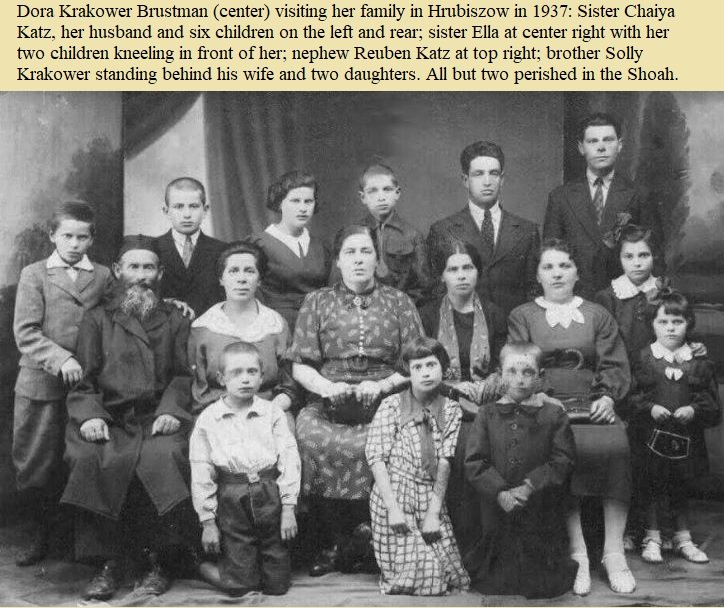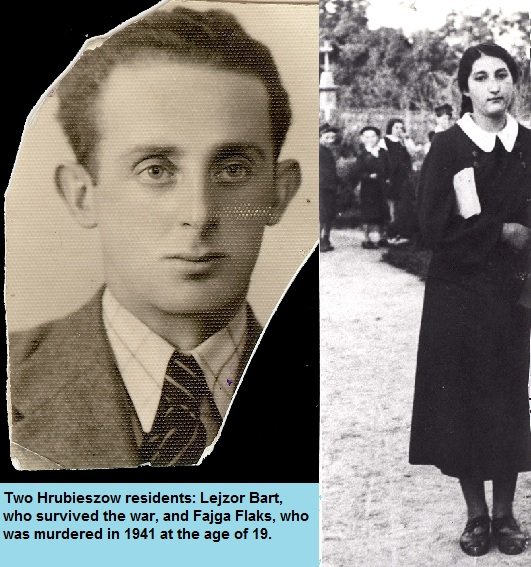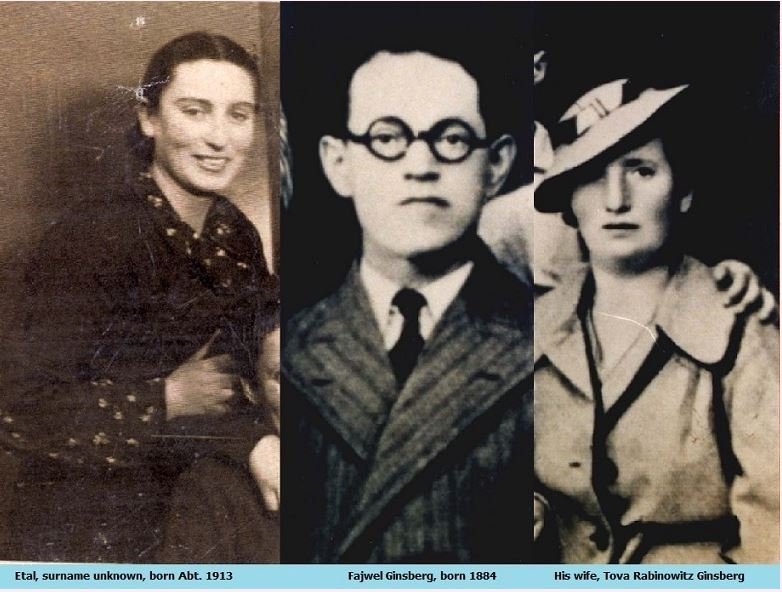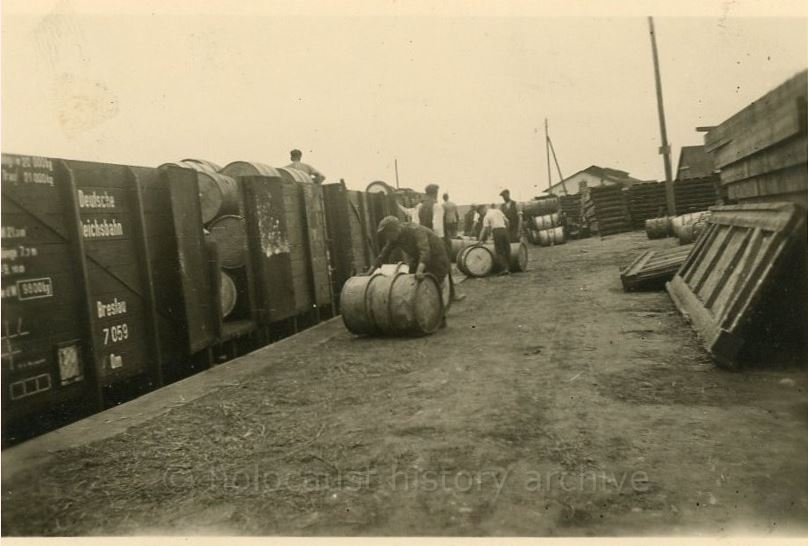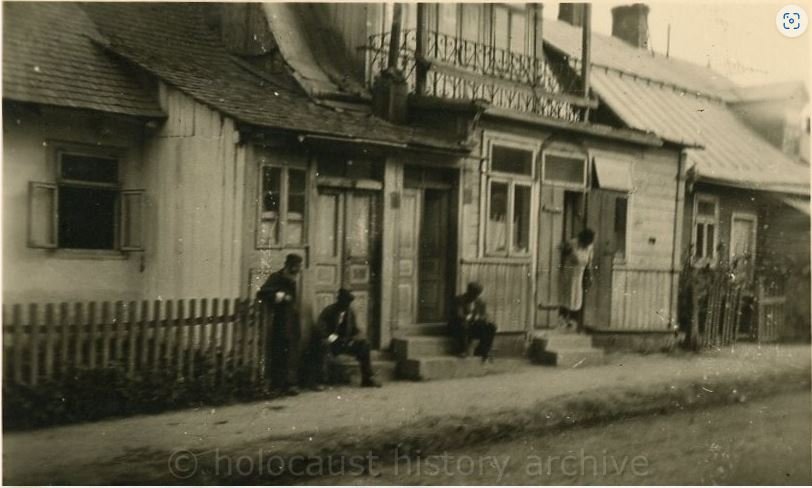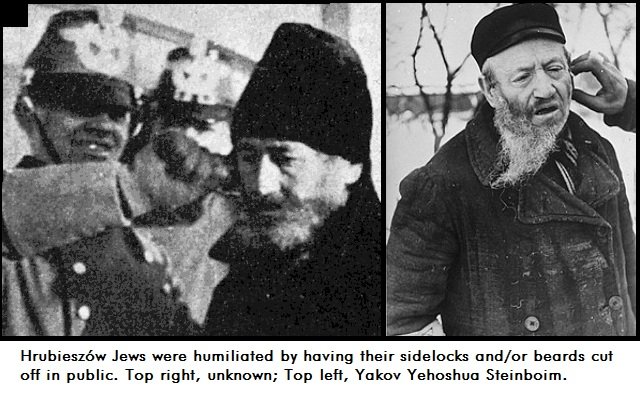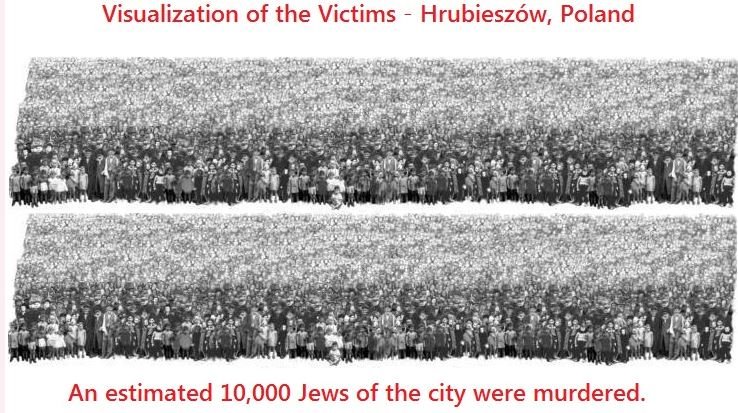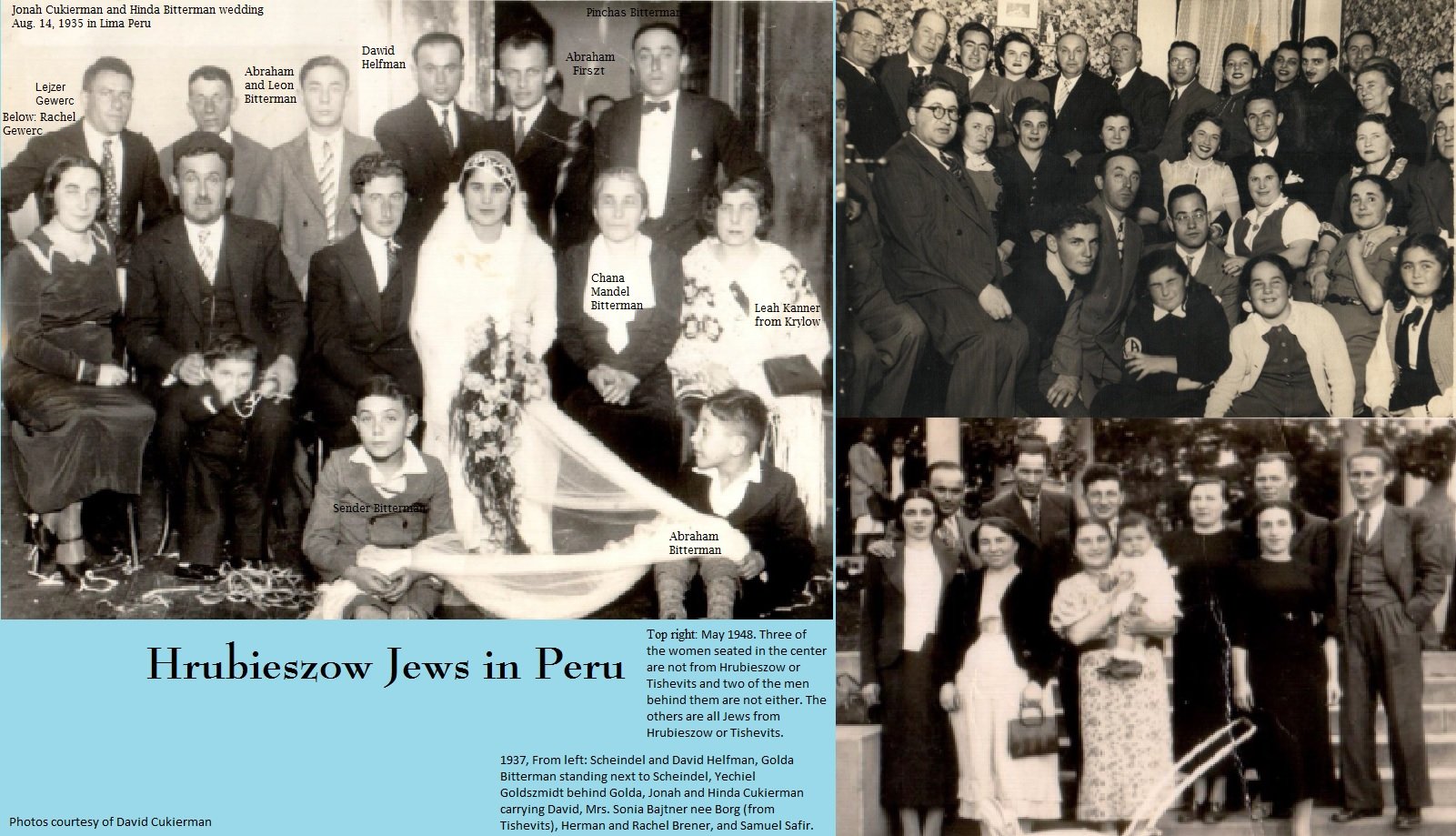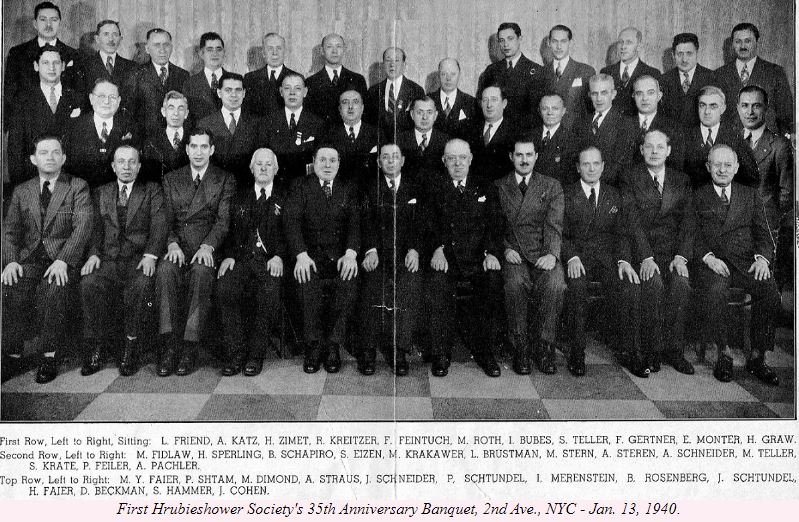Remember Jewish Hrubieszów
Pronunciations: Hrube-ee-esh-ov or Rubeshov
JEWISH HISTORY OF HRUBIESZOW
Hrubieszów is a city in southeast Poland, with a present population of 18,000. It is only 18 km. from the border checkpoint in Zosin and 5 km. (in a straight line) from the border with Ukraine over the Bug River. The first mention of the Jewish community is in 1440. From 1648 to 1657, there was a Cossack war of liberation from Poland called the Khmelnytsky Uprising, during which many Jews of the city perished. Twenty-seven Jewish houses and the smaller synagogue were destroyed in a fire in 1736. The leaders of the community and its rabbis were active on the Council of the Four Lands. The first Jewish-run hospital in Poland was inaugurated in
1818, a new synagogue in 1874, and an old age home in 1905. The Hasidim were active from the early 19th century, and between WWI and the Holocaust, the Zionists, Bund, and Agudat Israel were active in the city. There was also a brick synagogue as well as several houses of prayer.
In the Lwow Yizkor book, the Jewish wholesaler Josef (Josko) Ben Schachna, the son of a tax collector named Szachna from Hrubieszow, is mentioned. (Josef was the father of Rabbi Shalom Schachna.) It is said that Schachna settled in Lwow in the mid-15th century and occupied an important role in the life of the Jewish community. Josef inherited from his father a large estate. Josko eventually settled with his wife and 3 children in Lublin. After he died in 1507, Zygmunt I confirmed that the Shachnowicz family could continue to live among the Christians of Lublin, and that his monetary matters could be resolved via his will.
The Jewish population numbered 709 in 1765 and grew to 3,276 in 1856. By 1897 the Jewish population was 5,352 out of 10,636 total. The Jewish population before the war was 7,500. In the 1860s, the town had a clockmaker, two goldsmiths -- Hersz Wajsman and Szloma Cung -- as well as a printer -- Getzel Gutfeld. There were also two bookbinding workshops, run Chaim Fajfer and the Sojfer family. Some of the wealthiest merchants in the town were Yaakov Perec, Abram Brandt, Szloma Regel, Chamia Berliner, Josef Gertner, and Berko Szapiro. Other people of note, at the outbreak of the war, included: Fishel Zylbersztein, president of the Jewish hospital and orphanage; Szol Ajzen, landlord; Szmuel Brand, businessman; (unknown) Brand, Polish army officer and doctor; the Regiel family, owners of the steam mill; Yoel Rabinowicz, lawyer; (unknown) Krajcer, chemist; the Pucer family, grain trade; the Pachter family, tree trade; Zys Rojtman, owner of a factory and store; Berel and Laja Rozenblum, shoe store; (unknown) Szer, haberdashery shop; and (unknown) Gertel, owner of a store with electrical instruments.
The Jewish hospital in Hrubieszow was built in 1844 at Partyzantow street 31. Surgeon Dr. Zvi Hirsz Goldszmit (1804-1872) -- Janusz Korczak's grandfather -- worked there. In the interwar period there was an orphanage and a nursing home in addition to the hospital. The wooden building at Partyzantow street 11, which now houses the Social Music Center, before the war was functioning cheder. In the interwar period there were 9 houses of prayer in town. Two were founded around 1842. The next two were established around 1852, one about 1862, another about 1872, another two about 1892. One of them existed since 1916. One house of prayer were in private hands: Lejb and Frajda Sztern. The others were operated by organizations or associations.
In 1936 there was a ritual slaughterhouse in Hrubieszow that employed 9 people: Naftula Sztern, kosher meat supervisor; Jankiel Finkielsztejn, butcher; I. Engelsberg, a retired slaughterer; and ritual slaughterers Aron Fajngluz, Israel Liber, David Puter, Ajra Sokal, Moshe Winderbaum, and Judka Sztokhamer. Other Hrubieszow employees in 1936 included Srul Eng, janitor; F. Goldhur, secretary; Lejb Zajd and Icek Kirszner, synagogue sextons; Mordechai Cukier, cantor; Josef Wertheim and Hersh Blumencwajg, rabbi and assistant rabbi.
Jews also resided in villages near Hrubieszow, including: Bialopole (unknown number of Jews), Husynne (50 Jews), Jaroslawiec (unknown number of Jews), Miaczyn (50 Jews), Obrowiec (9 Jews), Strzelce (unknown number of Jews), Strzyzow (60 Jews), Trzeszczany (unknown number of Jews), and Werbkowice (75 Jews). The Jews in these communities were murdered in the Holocaust.
THE HOLOCAUST IN HRUBIESZOW
The Nazis entered Hrubieszow on September 15, 1939, and immediately organized a series of pogroms. Ten days later they withdrew, and the Soviet Army occupied the city, but after a Soviet-German agreement the city was returned to Nazi hands. During the pact period, 2,000 Jews fled with the withdrawing Soviet Army and entered Russian territory. On December 1, 1939, all Jewish men aged 15 to 60 were ordered to assemble on the Wigun common, a cattle-grazing area. About 1,000 Jews gathered there. All of their monies and valuables were taken from them at this time. The next day, 1,000 Jews from Hrubieszów and 1,100 from nearby Chelm were led on a death march to the Bug River, where 1,500 Jews perished. Additionally, at the Catholic cemetery at Kolejowej street (now called Kruczej), Jewish solders from the 1939 campaign were buried. Included among them are: Icek Zaks, Chaim Korentajler, Yaakov Mizer, Leon Mazur, and others
On August 13, 1940, German and Polish policemen arrested 800 Jews; 600 of them were deported to forced labor camps at Belzec for the construction of fortifications. Half of these Jews died in the camps from hunger and disease, and the remaining Jews in Hrubieszow lived in great fear of being sent to these camps. A registration conducted in October 1940 indicated there were 4,858 Jews in Hrubieszow. In early 1940, around 9,000 Jews including some refugees were confined to the Hrubieszów ghetto. The ghetto borders included Ludna Street, Jatkowa Street and Rynek Street. All Jews over the age of 12 were ordered to wear a white armband with a Shield of David on it. The Nazis appointed a Judenrat of 12 members, including Szmuel Brand, chairman, and Joel Rabinowicz, deputy chairman. The Judenrat was given the same tasks as in other Jewish communities: to supply the slave labor, to collect contributions, and to confiscate items of property.
In general, Judenrats in the Lublin district were not particularly compliant with the Nazi demands. The Hrubieszow Judenrat was no exception and did what it could to help the community. A soup kitchen was opened in the ghetto, as was a hospital with 30 beds. Medicine was given to the sick. In August, 1940, 500 Jews from Czestochowa arrived in the ghetto. Four labor camps were established in the vicinity, and each day hundreds of Jews, including young Jewish boys and girls, went off to pave roads, dig ditches, build bridges, and work on Polish farms. Labor camps in the Hrubieszow area where Jews were sent included: Busno (near Bialopole), Dolhobyczow, Mircze, Obrowiec, Oszczow, Tyszowce, and Wereszyn. In November, 1941, 300 Jewish deportees from Krakow arrived in Hrubieszów. In March of 1942, hundreds arrived in the city from Mielec. Jews were forced to give Poles their remaining possessions in return for food. In May, 1942 there were reportedly 5,690 Jews in the city of Hrubieszow. By June, it had reached 10,000 Jews. Crossing the borders of the ghetto was punishable by death, and the Germans enforced it with conviction. In September 1941, after the return of many Jews from the labor camps, the total Jewish population had risen to around 5,500 Jews. In April 1942, the JSS reported that there were 5,849 Jews in the town, including 1,194 refugees and deportees.
Five localities were designated as the collection points for Jews from the entire Hrubieszow powiat: Dubienka, Grabowiec, Hrubieszow, Uchanie, and Belz. In March, 1942, 1,343 Jews from Hrubieszow's ghetto were sent to the Belzec Death Camp gas chambers. Separately, a group of 1,800 Jews deemed fit for work were deported to Budzyn Labor Camp before April, 1942.
According to one testimony, more than 200 villages in the area of Hrubieszow were canvassed by the Nazis for the aktion of summer, 1942. More than 14,000 Jews were murdered in May and June of 1942 according to researcher David Silberklang. For this aktion, the Judenrat was told by German authorities the Jews would be sent to work in the Pinsk district. Instead, on June 1-2, 1942, Nazis assisted by Polish policemen assembled 3,049 Jews in the market square, put them aboard goods wagons and sent them to their deaths at Sobibor Death Camp.
Forty Jews who resisted in the market square were shot on the spot. A few days later, from June 7-9, the Nazis removed hundreds of remaining Jews from their houses. Despite some resistance, 180 Jews were taken to the cemetery and murdered there. At the Jewish cemetery at Kruczej street, the Germans carried out many executions of people of Jewish origin. Victims were buried in mass graves. One of these tragic events was witnessed by Motel Kaufman, who, after his liberation, faced the Jewish Historical Commission, and testified: "Three hundred corpses lay. They were tied up with a wire that was twisted around their hands. The people of Judenrat told me they were Jews whom the Germans found in their hideouts. They led them to the building of the Magistrate, they tied their hands there with wires and so they rushed to the cemetery where they shot them. I had to cross the wire. Then we buried them in a common grave. I was soaked with human blood." After the war, Abram Sher unveiled a monument dedicated to the victims of German crimes at the cemetery.
Between June 7-9, 1942, Jews who remained in Hrubieszow -- among them Jews from Grabowiec, Uchanie, Dubienka and Bialopole -- were taken to Sobibor Death Camp. This transport is described by eyewitness Dr. Michael Temchin, who was able to escape one of the train cars destined for Sobibor, in his book "The Witch Doctor." Some 3,400 Jews still remained in the city. In June of 1942, Jews concentrated in Belz were driven in a 31 mile death march to Hrubieszów. According to the Polish population, an additional 16 Jews were murdered at Strzelce near Bialopole. They were buried in the park near the local school.
Otto Busse, the local Nazi district leader, mobilized inhabitants of several places in Hrubieszow powiat who were armed with axes and sticks in order to hunt down Jews in hiding. From a German report for the period Nov. 16-Dec. 15, 1942, it emerged that as a result of local cooperation with the police, "five bunkers sheltering 65 bandits were finished off". (Note: Bandits is a reference to Jewish partisans.) Thus, Jews in the area had little opportunity for survival. Despite this, heroic partisan activities took place among the Betar, the Dror, and local Hrubieszow and Grabowiec residents. There was also an active resistance movement in the ghetto, led by Julek Brand and Leon Porecki (Aryeh Perec).
On June 1, 1942, Jews not registered as skilled workers were required to report to the marketplace. When it became clear that not all Jews had responded, the Nazi head of the local section for police affairs in Hrubieszow, Wilhelm Meyer, ordered the Gendarmerie, the Sonderdienst, a squad of Trawniki men, and the Jewish Police to collect additional Jews from the ghetto. The Sonderdienst applied considerable brutality in pulling Jews from the houses and driving them to the railway station.
The remaining Jews in Hrubieszow were working at German plants and were concentrated in a small ghetto close to the cemetery. On October 28, 1942, this ghetto too was closed, and most of its inmates sent to Sobibor, around 3,000 Jews. Some 400 Jews who resisted at the time of deportation were annihilated in the cemetery area. Jewish partisan Julek Brandt jumped off of his train-car destined for Sobibor, was reported to German authorities by Polish peasants, and then was forced to return to the Hrubieszow ghetto by the gendarmerie. He somehow convinced the Gestapo to create the Jatkowa street camp, where 200 (mostly young) Jews were able to work. They were forced to clean the ghetto and destroy the cemetery. In September of 1943, this group was sent to the Budzyn Labor Camp near Krasnik. Hrubieszów was liberated in July 1944 by the Red Army. The Nazis destroyed Jewish synagogues, cemetery, and private prayer houses in Hrubieszów. Around 10,000 Hrubieszów Jews were murdered in the Shoah. A Jew from Hrubieszow, Kalman Firszt, escaped from the Tuczyn ghetto to the forest, joined the Medvedev Brigade, and participated in actions against Germans/collaborators. He was killed in July of 1943 in Ukraine.
NAMES OF THE MURDERERS
Nazis implicated for murdering Jews during the Chelm-Hrubieszow march include: Josef Kraml, unknown Grosser, Josef Laska, Ludwig Pilles, Konrad Obermuller, Karl Scholz, Johann Stifter, unknown Weinreither, Josef Weissmann and officers in Belz Adolf Bohlmann, Karl Kohler, Karl Beier, Fritz Pietsch.
The Nazis in charge of the deportations and murders in Hrubieszow included: Senior Leadership: Richard Thomalla, Gestapo Commandant Weidermann, Commander of the Gendarmerie Henig (possibly Hening von Winterfeld), Dr. Walter Behrend, Otto Busse, Max Cichtski/Chichotsky (aka Max Runhof), Karl Vielweib, Bernhard von Loewen, Ferdinand Hahnzog; Regular Nazis: Alex (unknown),
Johann Ackermann, Helmut Altmann, unknown Astman, Julian Betcher, Johann Demant, Curt Englaender, Karl Hermann or Heinrich Franke, Hans Girtzig (who also served at Sobibor), unknown Grosser, Paul Groth (who also served at Sobibor), Gerhard Hacker, unknown Heitmuller, unknown Kiel, Arnold Klaus, Karl Knuhr, Josef Kraml, Josef Laska, Karl Mattulke, Wilhelm Meyer, Hermann Muller (possibly Johannes Muller), Gustav Nagel, Richard Nitschke, Konrad Obermuller, unknown Otto, Ludwig Pilles, Adolf Bohlmann (who was also involved in the murders at Zamosc), Ferdinand Radtke (who also served at Sobibor), Konrad Rimpler, unknown Ritzka, Arthur Rosenow, Hermann Sasse, Fritz Sauermann, Eberhard Schafer, unknown Schistel, Karl Scholz, Johann Stifter, Max Stobner (Stybner), Dr. Harry Georg Sturm (from Estonia), Werner Thunak, Hans or Johann Wagner, Adolf Waldner, unknown Weinreiter, and Josef Weissmann.
Thomalla was executed by the Soviet union in 1945. Busse committed suicide. Demant, perhaps the most brutal of the bunch (other than the rapist Groth), received a life sentence but did not serve it. Eberhard Schafer had a sentence of 15 years in prison, Harry Sturm and Adolf Walder had a sentence of 12 years each in prison, Max Stoebner served 9 years in prison, Richard Nitschke served 5 years in prison, and Wilhelm Meyer served 3 years in prison. Ebner, Nagel, Ratdke, Vielweib and von Loewen were killed during the war. Betcher, Hacker, Rimpler, Rosenow, Thunak, and Wagner were killed or died shortly after the war. All others listed were never punished for their crimes.
Please review the site content below. Zachor - We Remember.
------------------------------------------------------------------------
[Surnames and Researchers] [History] [Wikipedia - Hrubieszów]
[Holocaust] [Books about Lublin District Jewish Communities]
[Unidentified Photos of Hrubieszow Jews] [Notable Residents]
[Chelm-Hrubieszow-Belz-Sokal Death March]
[Jewish Partisans] [Betar Partisans from Warsaw in Hrubieszow]
[Yizkor Book - Hebrew] [Yizkor Book Translation - English] [Sephardim in Hrubieszow]
[Lublin Area Jewish Descendancy Organizations in Israel]
[Resources for Finding Your Jewish Family in the Lublin District]
-------------------------------------------------------------------------
Join the Hrubieszow group on Facebook!
Books about Hrubieszów:
Chaim Ajzen Remembers by Chaim Ajzen (Henry Steel)
Forbidden Strawberries by Cipora Hurwitz
I Shall Live by Henry Orenstein
Joszko Z Hrubieszowa by Krzysztof Pilarczyk
Little Dove in a Silent Garden: Fredzia Sztuden's Story by Shmuel Rothbard
My Holocaust Testimony by Meyer Megdal
Our Roots: Shorashim Shelanu by Zvi Einat
Pinkas Hrubieszów (Memorial Book of Hrubieszow) by Baruch Kaplinsky
(readable online)
Until Our Last Breath: Lejzor Bart's Story by Michael Bart
Until We Meet Again by Michael Korenblit
The Young Soapmaker (Testimony) by Leonard and Gertie Lerer
City of Hrubieszów:
Abraham Jakub Stern
Budzyn Labor Camp Description
(includes description from Hrubieszow's Abraham Dichter)
Chaim Ajzen's Holocaust Resistance
Description of Hrubieszow During War - Mrs. Dichterman/Dychterman
Frumke and Chajke: Jewish Resistance in Hrubieszow
Horodlo Yizkor Book
Hrubieszow Discussion Group
Hrubieszow Genealogy Group (outdated)
Postcard from the Judenrat of Hrubieszow
Sephardim in Hrubieszow
Ustilug Yizkor Book
Concentration and Labor Camps:
Ghetto Listing: Poland
Belzec Death Camp
Budzyn Labor Camp
Majdanek Death Camp
Majdanek Sub-Camp: Trawniki
Plaszow Concentration Camp (Krakow)
Return to Majdanek: Cipora Hurwitz
Sobibor Death Camp
Stutthof Concentration Camp
Lists from Hrubieszów:
First Hrubieshower Sick Benevolent Society
Hrubieszow Death March Victims - "Sefer Ha'Zvaot"
Hrubieszow Ellis Island Records
Hrubieszow Burials in NYC
Surnames in NYC Hrubieszow Burials
Pinkas Committee from 1962 (page 431)
Families of Hrubieszów:
Arbis family
Biterman family
Blatt family
Blender family
Brustman/Krakauer family
Edelman family
Feil family
Finger family
Folk family
Goldbaum family
Gruber family
Heryng family
Hus family
Kleiner family
Lerer family
Migdal family
Orenstein family
Penik family
Rosenfeld family
Schuchman family
Tenenbaum family
Zajdman family
Survivors of Hrubieszów:
Note: Additional survivors listed in Pinkas HaNitzolim II
Yeheskel Ader
Shaul Aizen
Chaim Ajzen (Henry Steel)
Heniek Alt
Ethel Apel Ajzenkranz
Shmuel Apel
Lejzor Bart
Lejb Berenstein
Moses Bergerson
Jakub Biskubicz
Judah Biterman
Shmuel Biterman
Alexander Blady
Abraham Blander (video testimony)
Rachel Blass
Matale Blender (testimony)
Icek Boden
Irena Boden
Lea Boden (went to Kalmar, Sweden)
Rivka Boden
Szloma Brand
Moshe Brener
Shmuel Brener
Usher Cukierman (went to Israel)
Chaim Cymerman
Malka Cymerman
Jakub Czuch
Tuli Czuchowicz
Wolf Danziger
Yochewed Deutch
Abraham Dichter
Chaskiel Drucker
Heniek Drut
Moshe Drut
Tuwia Dwosz (sp?)
Enrique Dychter
Jojne Dyksztejn
Brania Eber
Abram Eisen
Joseph Epstein
Guta Fajfer
Michael Finger (Drori)
Bencio Fink
Eve Finkelstein Silver
Jacob Finkelstein
Jean Finkelstein Peltz
Pesia Folk
Rosa Gelertner Frenkel
Chaja Gal
Hersh Zvi Geist
Zelman Gelertner
Raymond Geller
Eliahu Gertel
David Gewirtz
Natan Giewerc
Zvi Goldberg
Isaac Goldman (went to Argentina)
Estera Guss
Nechama Goldberg Kaspi
Nathan Hadass
Sura Harfin (went to Sweden)
Josef Hendel
Mordechai Horowitz
Tsiporah Horvits
Cipora Hurwitz, aka Fela Rozensztajn (video testimony)
Helen Firszt Jakubowski (video testimony)
Schyja Martin Kaner
Serka Katz
Dora Klak
Hersz Klahr
Matla Kleiner Blander
Meyer Kornblit
Winda Kutna
Harry Nagelsztain
Manya Nagelsztajn Kornblit
Abram Lehrer
Leonard (Lejb) Lehrer
Joseph Luft
Sarah Luft
Simon Luft
Yitte Luft
Wolf Luft
Moshe Maskal
Meyer Megdal
Naphtali Meil
Joseph Mermelstein
Nathan Milstein
Sam Milstein
Sara Mostysser
Chaim (Harry) Nagelsztajn
Pinchas Nusel
Shalom Omri (Schwartz)
Fred Orenstein (testimony)
Henry Orenstein (testimony)
Sam Orenstein
Gunia P.
Hersh Pachter
Leo Peltz
Lolek Peretz
Sabina Peterseil
Eliezer Poliushko
Joseph Pomp
Herschel Pucer (went to Germany)
Kopel Rabinowitz (Esteron)
Bencion Ratniewski
Avram Retig (Abraham Rejtig)
Yankale Jacob Rosenblatt
David Rotenberg
Zipora Rozensztajn Hurwitz
Mendel Saler (went to Australia)
Yankel Saler (went to Australia)
Josef Scher
Nathan Scher
Regina Sherer Franks
Molly Weisbrot Schneiderman
Moshe Schneiderman
Shalom Schwartz
Abraham Silberstein
Hy Silberstein
Eliahu Silverblech
Chil Streiter
Joseph Streiter
Mendel Streiter
Chaim Strum (Szturm)
Joziek Strum (Szturm)
Fredzia Studen Rothbard
Szmul Szlechter
Josef Sztajnwurcel
Lejzor Sztokhamer (went to Israel)
Jozefa Karpik Szypulka (non-Jew)
Josef Szwarcz (Schwartz)
Szloma Szwarcz (Schwartz)
Ruth Hudes Tatarko (video testimony)
Shmuel Tepper
Yankel Tschechovitz (Tschechowitz)
Jacobo Wajs
Szlema Weiner
Israel Weiss
Basha Weisbrot
Jacob Weisbrot
Jankiel Weisbrot
Malka Weisbrot
Moshe Weisbrot
Wanda Wolosky
Hanna Zak
Chaim Zelcer (went to Israel)
Chaim Zemel
Eliyahu Zilberblech
Chaim Zilberstein
Avraham Zimmerman
Meir Ziss
Mejer Zojm (went to Lithuania)
Helen Zuberman
Rabbis of Hrubieszow:
Chaim (Chajke) ber Shmuel Halevi Horowitz, until 1665
Meshulem Feibush ber Menachem Ginzburg, 1667
Yakov Ben Tzvi Hirsz
Avraham Avli Zak
Yitzhak Charif, 1695
Shmuel Margules
Natan Aryeh (grandson of the Pnei Yehoshua)
Aryeh Leibush ben Meir Kantschiner
Yoel ben Dawid Katzenellenbogien
Ze'ev Wolf
Moshe Yitzhak
Chaim Hochgelernter
Yosef Shpira (Szapiro), early 19th century
Yosef ben Mordechai Katzenellenbogien, 1818
(unknown) Hillel, 1824
Josef Eliezer Gelernter, until 1864
Moshe Klug, 1878
Efraim Zalman Rokach (Rokeach)
Izrael Isser Jawic, 1896
Yaakov Aryeh Leib Twersky (Trisker Rebbe), died 1918
Moshe Lejb Berman, rabbi of Horodlo
Yitzhak Najmark
Zvi Hersh Rosenzweig
Naftali Rokeach
Josef Wertheim, 1924-1935
Yochanan Twerski, 1936-1939
Righteous Gentiles:
- Rozalia Baran was murdered for giving her identification papers to a Jewish woman.
- Alfred Haponski saved Chaja Papir by giving her false identification papers.
- Franciszek and Stefania Mroczkowski hid Elzbieta Heinberg.
- Aleksandra Rachwalski in Stary Wies was killed along with a Jewish man and his son.
- Janina Sedlakowski in Zwierzyniec was executed for providing aid to Jews.
- Nikolay and Mikhail Vavrisevich rescued six Jews from Horodlo, Poland.
- Majtek and Katja Bodniewski from Horodlo hid Frajdel Perlmuter for two years.
Notable Residents:
Notable Residents
Sofia Apteiker (Sarah Freynd)
Jacques Calmanson
Zvi Faier
Leah Krause Miller
Avraham Sztern (Stern)
Shmuel Tepler
Notable Descendants:
Yosef Almogi, Israeli Knesset member
Daniel Goldman, Argentinian Rabbi
David Kimche, former director of Israeli Mossad
David Mamet, American playwright
Zalman Shazar, past president of Israel
Genealogy:
Eichmann Trial Transcripts Document Hrubieszów Events
Frumka Plotnik and Hava Follman Eyewitness Testimony: Hrubieszow
Hrubieszow Records in Israel
Jewish Records Indexing Poland - Hrubieszów
Jewish Vital Records in the Polish State Archives
Remember Your Family:
The DNA Shoah Project: Connecting Descendants
Central Judaica Database - Museum of History of Polish Jews
Grandchildren of Holocaust Survivors on Facebook
Guide to the YIVO Archives
Holocaust News/Events from Generations of the Shoah Int'l
Holocaust Survivors and Victims Database
JewishGen Family Finder
JewishGen Holocaust Database
JRI-Poland: Search for Your Family
Museum of History of Polish Jews Introduction
Yad Vashem: Search for Your Family
Yad Vashem: Submit Names of Your Family Members
Yad Vashem Requests Photos of Shoah Survivors and Families
CONTACTS
ISRAEL: Aaron Estaron, estar1@zahav.net.il
The Israeli Organization of Hrubieszów Descendants
http://www.hrubieszow.org.il/en/
U.S.: LublinJewish@gmail.com
Return to Jewish Lublin -- Index





